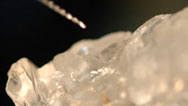Martian Salt
- Posted 04.01.09
- NOVA scienceNOW
What would it mean if we found cellulose in salt deposits on Mars just like those found in salt crystals here on Earth? For planetary geologist Phil Christensen, it would say one thing: "Wow, Mars had life." In this video extra, hear from Christensen and others on the potential for such a discovery.
Transcript
Martian Salt
Posted: April 1, 2009
JACK GRIFFITH: It was very exciting to photograph biological material that is 253 million years old and is still trapped in the salt. These are clearly the oldest direct evidence of life on the planet.
NARRATOR: The team's find might even shed light on another ancient world, but this one is millions of miles away.
JACK GRIFFITH: If the cellulose survived a quarter of a billion years here on Earth, is it quite possible that it would survive that long on the surface of Mars? Cellulose might be the ideal paper trail for the search for life on other planets.
NARRATOR: When we think of alien life, this scene may come to mind; A Close Encounter of the Third Kind. But in reality, alien life may be a lot more basic – as basic as salt. That's what Phil Christensen, professor of planetary geology at the University of Arizona is hoping for. Phil developed the imaging system for the Mars Odyssey mission. It works a lot like a camera but records a thermal signature instead of light.
PHIL CHRISTENSEN: So what we're measuring is the amount of energy that you're giving off.
NARRATOR: And so my nose then is hot or cold, would you guess?
PHIL CHRISTENSEN: Your nose is cold.
NARRATOR: That would be correct.
NARRATOR: Millions of miles away on the Martian surface this camera can distinguish one mineral from another based on its thermal signature. In Phil's images each mineral is assigned a different color. Salt is blue.
PHIL CHRISTENSEN: You can see on Mars some of the classic salt cracks and salt pan desposits that you see in salt formations on the Earth. I believe that if Mars ever had life, we will find evidence here. So when Jack's results came along saying you can actually preserve cellulose in salt, in our minds, that made these types of deposits vastly more interesting.
NARRATOR: And what do you think we're going to find in there?
PHIL CHRISTENSEN: I'll be ecstatic if we go and find even the building blocks of life, the organic compounds. But if we found cellulose, then, wow, Mars had life.
JACK GRIFFITH: On other planets there probably aren't little green men, but there may be cellulose, and that may be as close as we'll get to proving that there is life out there.
NARRATOR: It may not be the kind of close encounter we've seen in the movies, but something that's a lot more tangible—one of nature's sturdiest little molecules, buried in crystals of salt.
Credits
- Produced for NOVA scienceNOW by
- Terri Randall and David Chmura
- Video
- © WGBH Educational Foundation
Related Links
-

Secrets in the Salt
Salt deposits that formed 250 million years ago hold tantalizing hints of early life.
-

Secrets in the Salt: Expert Q&A
Jack Griffith answers questions about cellulose, DNA, and other organic bits found in Permian salt deposits.
-

Trapped in Salt
Biophysicist Jack Griffith takes you on a narrated photo tour of quarter-billion-year-old water bubbles.
-

A One-Way Trip to Mars?
Initial shock aside, some space scientists argue this is the only way to go.



